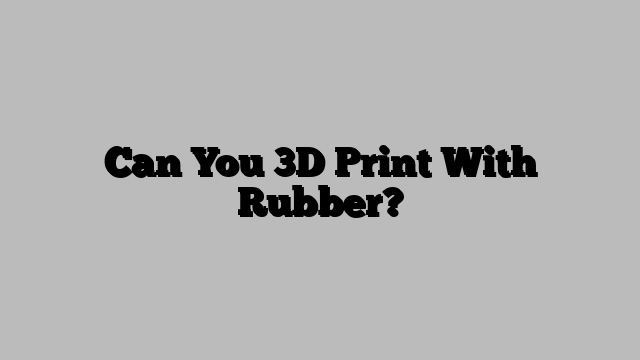Rubber is a versatile material used in a variety of applications, from footwear to automotive parts. But can you 3D print with rubber? The answer is yes, but with some limitations. In this article, we’ll explore the possibilities and limitations of 3D printing with rubber and provide actionable insights to help you understand the process.
Types of Rubber Filament
There are several types of rubber filament available for 3D printing, including TPU (thermoplastic polyurethane), TPE (thermoplastic elastomer), and Flexibles. TPU and TPE are thermoplastic materials that combine the properties of rubber and plastic, making them ideal for 3D printing. Flexibles are a type of TPU that can stretch and bend without breaking, making them ideal for creating flexible or articulated parts.
Printing with Rubber Filament
Printing with rubber filament is similar to printing with other materials. However, there are some key differences to consider. First, rubber filament is generally more flexible and stretchy than other materials, which can make it more difficult to print with. Second, rubber filament requires a slower print speed and lower layer height to ensure the material adheres properly to the print bed. Finally, rubber filament may require a higher extruder temperature and slower cooling time to ensure the material maintains its flexibility.
Post-Processing
Post-processing is an important consideration when 3D printing with rubber. Unlike other materials, rubber filament may require additional steps to clean up the print and improve its appearance. For example, removing support structures from a rubber print may require a different approach than removing supports from a plastic print. Additionally, rubber prints may require some sanding or filing to smooth out any rough edges or imperfections.
Applications of 3D Printing with Rubber
There are many potential applications for 3D printing with rubber, from creating flexible phone cases to printing gaskets or seals. Rubber filament is also useful for creating parts with complex geometries or intricate designs that may be difficult or impossible to create with traditional manufacturing methods.
3D printing with rubber is possible with the right materials and settings. TPU, TPE, and Flexibles are popular rubber filaments that can be used for a variety of applications. However, 3D printing with rubber requires some adjustments to the printing process and post-processing steps to ensure the material is printed correctly and looks good. With practice and experience, you can master the process of 3D printing with rubber and create high-quality, flexible prints for a variety of applications.
